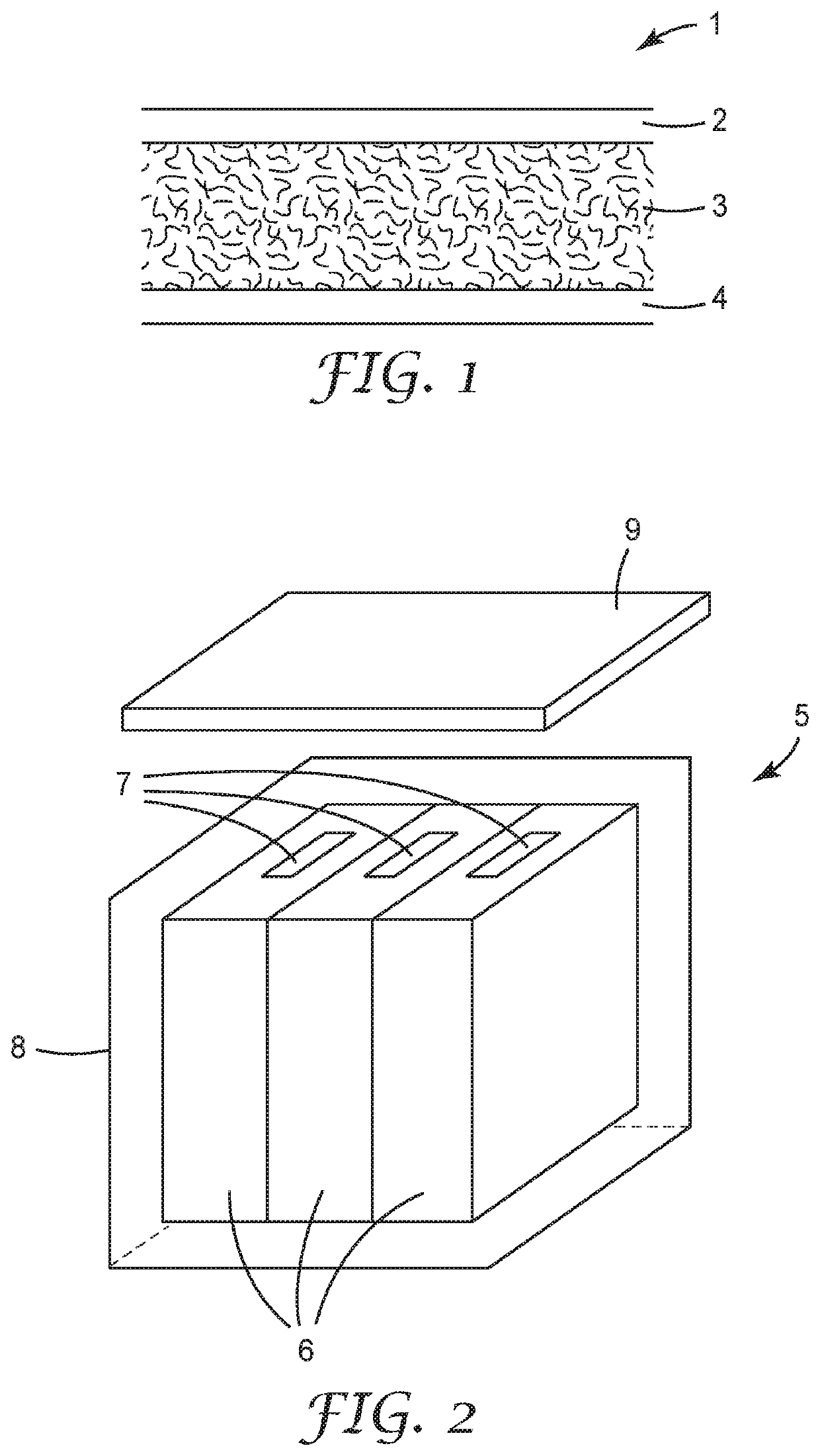Thermal barrier material for a rechargeable electrical energy storage system
a technology of electrical energy storage and thermal barrier material, which is applied in the direction of inorganic insulators, batteries, cell components, etc., can solve the problems of unwanted effects, overheating and then thermal runaway, and further increase of reaction rate and in turn of generated heat, etc., and achieves the effect of convenient us
- Summary
- Abstract
- Description
- Claims
- Application Information
AI Technical Summary
Benefits of technology
Problems solved by technology
Method used
Image
Examples
examples 1-3 (
EX1-EX3)
[0112]The multilayer laminates of Examples 1-3 were prepared by spraying 3M Display Mount spray adhesive onto a fabric. A fiber mat was placed the fabric on top and then rolled with a 4.54 kg (10 lbs.) roller. Sample constructions are represented in Table 1 and test performance data are provided in Table 2.
examples 4-6 (
EX4-EX6)
[0113]The multilayer laminates of Examples 4-6 were prepared by using a #30 Mayer rod to draw down and apply K® sodium silicate adhesive onto a CEQUIN I inorganic insulating paper material. The inorganic fabric layer was then placed on top of the inorganic adhesive layer and then rolled with a 4.54 kg (10 lbs.) roller. The multilayer laminate was then dried at 82° C. (180° F.) for five minutes. For example, EX6, a second layer of the K® sodium silicate adhesive was applied to the other side of the CEQUIN I inorganic insulating paper using a #30 Mayer rod. A second inorganic fabric layer was then placed on top of the second inorganic adhesive layer, rolled down with a 4.54 kg (10 lbs.) roller and dried at 82° C. (180° F.) for five minutes. Sample constructions are represented in Table 1, selected physical, mechanical and electrical properties are provided in Table 2, and Thermal / flame barrier test performance data are provided in Table 3.
TABLE 1Sample Constructions for Exampl...
examples 7-13 (
EX7-EX13)
[0117]Multilayer laminates of Examples 7-13 were prepared by using a #30 Mayer rod to draw down and apply the inorganic or modified inorganic adhesive onto a 20 mil CEQUIN I inorganic insulating paper material. A layer of TG 430 glass cloth fabric was then placed on top and rolled down with a 4.54 kg (10 lbs.) roller. The multilayer laminate was dried at 180° F. (82° C.) for 5 minutes. Example 14 was prepared following the same procedure as Example EX7-EX13 except that SC2025 calcium silicate coated fiberglass fabric was bonded to 20 mil CEQUIN I inorganic insulating paper material with a KSS inorganic adhesive in place of TG430 glass cloth fabric. Sample constructions are represented in Table 4 and test performance data are provided in Table 5.
TABLE 4Sample Constructions for Examples 7-14 and Comparative ExamplesLaminate BasisLaminateWeight Thickness ExampleLamination Adhesive*(gsm)(mm)EX7100 wt. % KSS 938.5 0.88EX899.96 wt. % KSS and 0.04 wt. % 896.7 0.92SELVOL 9-325EX...
PUM
| Property | Measurement | Unit |
|---|---|---|
| thickness | aaaaa | aaaaa |
| total thickness | aaaaa | aaaaa |
| thermal conductivity | aaaaa | aaaaa |
Abstract
Description
Claims
Application Information
 Login to View More
Login to View More - R&D
- Intellectual Property
- Life Sciences
- Materials
- Tech Scout
- Unparalleled Data Quality
- Higher Quality Content
- 60% Fewer Hallucinations
Browse by: Latest US Patents, China's latest patents, Technical Efficacy Thesaurus, Application Domain, Technology Topic, Popular Technical Reports.
© 2025 PatSnap. All rights reserved.Legal|Privacy policy|Modern Slavery Act Transparency Statement|Sitemap|About US| Contact US: help@patsnap.com

